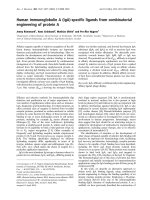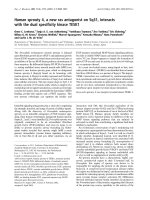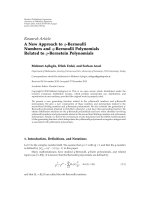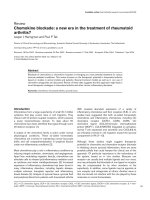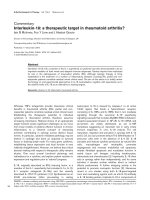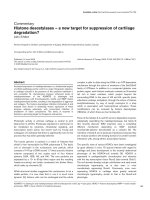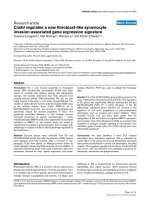Báo cáo y học: "Human depression: a new approach in quantitative psychiatry" pdf
Bạn đang xem bản rút gọn của tài liệu. Xem và tải ngay bản đầy đủ của tài liệu tại đây (955.89 KB, 6 trang )
Cocchi et al. Annals of General Psychiatry 2010, 9:25
/>Open Access
REVIEW
© 2010 Cocchi et al; licensee BioMed Central Ltd. This is an Open Access article distributed under the terms of the Creative Commons
Attribution License ( which permits unrestricted use, distribution, and reproduction in
any medium, provided the original work is properly cited.
Review
Human depression: a new approach in quantitative
psychiatry
Massimo Cocchi*
1,2,3
, Lucio Tonello
1,3
and Mark M Rasenick
4
Abstract
The biomolecular approach to major depression disorder is explained by the different steps that involve cell
membrane viscosity, Gsα protein and tubulin. For the first time it is hypothesised that a biomolecular pathway exists,
moving from cell membrane viscosity through Gsα protein and Tubulin, which can condition the conscious state and is
measurable by electroencephalogram study of the brain's γ wave synchrony.
Introduction
The need for a deep, radical turning point in the world of
psychiatry is rapidly growing. Present diagnostic meth-
ods cannot continue to be considered acceptable because
they are almost completely based on the psychiatrist's
opinion, which does not have an objective diagnostic
technology and thus has a very high error rate.
A debate is essential between the advocates of tradi-
tional diagnostic and therapeutic methods and advocates
of emerging methods resulting from new discoveries.
Major depressive disorder and other related and non-
related psychiatric conditions are still characterised and
defined by descriptive and non-biological criteria, but it
is hoped that we can adequately characterise this and
other psychiatric disorders with the addition of new
quantitative approaches.
Human depression in the interpretation of an artificial
neural network
Following the theory that a biomolecular involvement of
the cell could be an expression of a psychiatric disorder,
we have tried to understand and explain this phenome-
non.
The intention was to study the platelet fatty acids com-
position in normal and depressed subjects [1], because of
their similarity to neurons [2-10].
Membrane platelet fatty acids of subjects with a clinical
diagnosis of major depression versus apparently normal
subjects were assessed. The complexity of membrane
dynamics has also suggested study by means of non-lin-
ear advanced analytical tools would be appropriate. In
particular, it seemed more appropriate to use artificial
neural networks: the self-organising map (SOM)
Kohonen network [11-13]. This particular algorithm
allows viewing of the result graphically, building a two-
dimensional map that places the subjects in a continuous,
not necessarily dichotomised way.
The values for fatty acids in the two populations were
entered into the SOM, mixing normal and pathological
subjects and hiding the information relating to their path-
ological condition. The SOM was then used to map the
two populations using three specific fatty acids: palmitic
acid (PA), linoleic acid (LA) and arachidonic acid (AA),
which represent the majority of total membrane fatty
acids, recognising as similar those belonging to the same
population and then separating the normal cases from
the pathological cases [1]. All the artificial neural net-
works (ANNs) tested gave essentially the same result.
However, the SOM gave superior information by allowing
the results to be described in a two-dimensional plane
with potentially informative border areas. The central
property of the SOM is that it forms a non-linear projec-
tion of a high-dimensional data manifold on a regular,
low-dimensional (usually 2D) grid.
This experiment was performed outside of evidence-
based medicine (EBM) rules. The direct task of finding
biomarkers according to the EBM rules requires the elim-
ination of selection bias, and in psychiatric illness the
leads to the selection of a population that is often clini-
cally unrealistic. The results are shown in Figure 1a, b.
The SOM has shown considerable correlation to the
clinical diagnosis of major depression, and indeed,
revealed the existence of differences within the same
* Correspondence:
1
DIMORFIPA, University of Bologna, Italy
Full list of author information is available at the end of the article
Cocchi et al. Annals of General Psychiatry 2010, 9:25
/>Page 2 of 6
diagnosis. The literature shows that a diagnosis of major
depression is very often misleading, and can be changed
to a diagnosis of bipolar disorder [14].
Using the following equation (Equation 1), which
relates each fatty acid percentage with the melting point
and the molecular weight, we obtained a result that led us
to understand that platelet membranes had different
degrees of viscosity and/or unsaturation (B2 index).
Where A
i
= percentage of i-th fatty acid, mp = melting
point, mw = molecular weight, mw
i
= molecular weight of
i-th fatty acid, mp
i
= melting point of i-th fatty acid, and i:
• 1 = palmitic acid, C 16:0
• 2 = linoleic acid, C 18:2
• 3 = arachidonic acid, C 20:4
The result clearly showed that the platelet membranes
of depressive subjects were characterised by a much
higher degree of fatty acid unsaturation than normal sub-
jects.
According to Donati et al. [15] rapid changes in mem-
brane lipid composition or in the cytoskeleton could
modify neuronal signalling. As this could have implica-
tions for a new understanding of some aspects of psychi-
atric disorders, a private meeting was organised in
Bologna (Faculty of Veterinary Medicine) and in Treviso,
University, October 2008) with some expert scientists in
the field (Kary Mullis and Stuart Hameroff ).
Three essential points constituted the crucial elements
of the discussion at the meeting: (1) the viscosity of the
platelet and neuronal membrane; (2) the protein Gsα; (3)
the relationship between tubulin and consciousness.
With regard to the first point, Cocchi and Tonello
observed that the platelet membrane was substantially
differentiated from a chemical point of view with regard
to the indexes of saturation between depressed and nor-
mal populations [1].
On the second point, the protein Gsα modifies its
structure according to the degree of viscosity of the neu-
ronal membrane, as seen in patients who commit suicide
for psychiatric reasons in comparison to deaths from
other causes [15].
With regard to the third point, Tubulin, because of its
connection to Gsα and its position in the cellular
cytoskeleton, determines those changes that have been
assessed with quantum computation under conditions of
wakefulness in comparison to the condition of anaesthe-
sia [16].
Biomolecular depression hypothesis
A very suggestive hypothesis was built, as summarised in
Figure 2.
Figure 2 describes the molecular depression hypothesis
formed according to the experimental findings of Cocchi
et al. [1], Donati et al. [15], Hameroff and Penrose [16,17]
and Hameroff [17]. Because of the possible similarity in
behaviour of platelets and neurons, membrane viscosity
may therefore modify the Gsα protein status. The Gsα
protein is connected with tubulin. Tubulin, depending on
local membrane lipid phase concentration, may serve as a
positive or negative regulator of phosphatidylinositol bis-
phosphate (PIP2) hydrolysis, as G proteins do. Tubulin is
known to form high-affinity complexes with certain G
BA
mp
i
mw
i
i
i
2
1
3
=
⎛
⎝
⎜
⎞
⎠
⎟
=
∑
Figure 1 Distribution of the human subjects (normal and depressive) over the self-organising map (SOM) (a), and SOM areas (b). (a) The dis-
tribution of the 144 subjects studied, 60 apparently healthy (green) and 84 diagnosed as depressed (red) effected by the SOM allowed us to identify
4 areas: 2 specific ones (exclusively normal and exclusively pathological) and 2 mixed with different concentrations of pathological subjects and ap-
parently normal subjects of the sample. The red subjects in the two intermediate areas (yellow and orange) have been interpreted as having a mis-
leading diagnosis of major depression, as described in the literature [14]. (b) SOM areas. Green = normal, red = depressive, yellow = high density of
normal subjects, orange = high density of pathological subjects.
A
B
Cocchi et al. Annals of General Psychiatry 2010, 9:25
/>Page 3 of 6
proteins. The formation of such complexes allows tubulin
to activate Gα protein, which, in turn, can activate pro-
tein kinase C (PKC), and fosters a system whereby ele-
ments of the cytoskeleton can influence G-protein
signalling. PKC activation (Figure 3) is preceded by a
number of steps, originating from the binding of an extra-
cellular ligand that activates G-protein on the cytosolic
side of the plasma membrane [18].
The G-protein, using guanosine triphosphate (GTP) as
an energy source, then activates PKC via the PIP2 inter-
mediate, the diacylglycerol/inositol triphosphate (DAG/
IP3) complex [15]. The schematic biomolecular mecha-
nism of the Gsα protein is described in Figure 4.
Figure 3 Description of protein kinase C (PKC) activation.
Figure 2 Description of the biomolecular steps possibly involved in depressive disorder.
Cocchi et al. Annals of General Psychiatry 2010, 9:25
/>Page 4 of 6
The Gα subunit is activated and starts a cAMP signal-
ling cascade, as shown in Figure 5.
The international scientific literature has reported
abnormalities in the cAMP signalling cascade of the
human brain in suicidal and depressive subjects for over
two decades [19-25].
According to Donati et al. [15] there is a further possi-
ble condition: the position of Gα (Gsα in particular)
within the lipid raft microdomain. Lipid rafts are special-
ised structures on the plasma membrane that have an
altered lipid composition as well as links to the cytoskele-
ton (Figure 6). They are local lipid microdomains that
float in the liquid-disordered lipid bilayer of cell mem-
branes. The effect of lipid rafts on neurotransmitter sig-
nalling has also been implicated in neurological and
psychiatric diseases [26].
Raft localisation of Gsα in human peripheral tissue
(possibly platelets, see [15]) may thus serve as a bio-
marker for depression. Several studies using human
platelets suggest that adenylyl cyclase may, in fact, serve
as a biological marker for depression [27-34].
The membrane fatty acid-Gsα hypothesis
It is known that G proteins could be targeted to raft
domains by several mechanisms. The most plausible
mechanism is that Gα subunits are subject to palmitoyla-
tion. Palmitoylation is a process of covalent attachment of
palmitic acid to cysteine residues of membrane proteins.
Palmitic acid is one of the three fatty acids (together
with arachidonic acid and linoleic acid) used by SOM as
marker of depression [1].
Is the critical composition of the membrane platelet
fatty acids an indirect measure of the G protein status?
(see Figure 7.)
Rapid changes in membrane lipid composition or in the
cytoskeleton might modify neuronal signalling. Hameroff
hypothesised that through this mechanism it is possible
to modify the consciousness state [16,17]. According to
Hameroff [16,17] the best measurable correlate of con-
sciousness is a γ synchrony electroencephalogram (γ
waves are a pattern of brain waves, with a frequency
between 25 to 100 Hz, prototypical at 40 Hz), which
indeed rapidly moves and redistributes throughout the
brain. γ Synchrony derives not from neurocomputation,
but from groups of neuronal dendrites (and glia) tran-
siently fused by electrical synapses called gap junctions,
more or less sideways to the flow of neurocomputation.
The process could be mediated by tubulin and its corre-
lates i.e. membrane viscosity and Gsα protein (see Figure
2).
Recent studies reported a model of the disconnection
hypothesis of schizophrenia through the demonstration
of abnormal stimulus induced γ phase synchrony [35].
The idea discussed by the authors with Hameroff and
Mullis that platelets could represent the peripheral mark-
ers of the depressive disorder and that platelets are 'brain
ambassadors', has become a more and more realistic pro-
posal [36].
Conclusions
On the basis of the above-cited research it is possible to
try to understand and quantify some of the biological
aspects that characterise depression in order to enable an
Figure 5 cAMP signalling pathway.
Figure 6 Schematic representation of a lipid raft microdomain.
Figure 4 Ligand reaches the receptor and guanosine-5'-triphos-
phate (GTP) reaches the protein. Cell membrane proteins coupled
to cell surface receptors bind to GTP upon stimulation of the receptor
by an extracellular signalling molecule (as a hormone or neurotrans-
mitter) to form an active complex that mediates an intracellular event
(for example, activation of adenylate cyclase).
Cocchi et al. Annals of General Psychiatry 2010, 9:25
/>Page 5 of 6
objective diagnosis to be made through simple and inex-
pensive blood tests. Such tests, and the biomolecular
pathways upon which they are based, would also repre-
sent early indicators of therapeutic effectiveness. These
possibilities represent a genuine revolution not only in
psychiatry but more generally in the worlds of neurosci-
ence and medicine, as Mullis and Hameroff have high-
lighted in a recent interview on the subject [37,38].
Observed changes in the serotonergic and microtubu-
lar systems in the hippocampus following restraint stress
confirm the structural [39,40] and biochemical [41] vul-
nerability of this area to stressful conditions. Cytoskeletal
changes represent a potential new pathway that may
increase our understanding of psychiatric disorders. The
question of whether or not changes in 5-hydroxytryptam-
ine (5-HT)-serotonin levels are related to changes in the
expression of tubulin needs to be assessed by future stud-
ies [42]. Already in 1980 it has been shown a relationship
between serotonin receptors and lipid membrane fluidity:
as the membrane lipids become more viscous, the spe-
cific binding of serotonin increases steadily. Signal trans-
duction, either through activation of adenylate cyclase by
the ligand-receptor complex or by microaggregation of
ligand-receptor complexes, is associated with lateral
movements of components of the membrane which are
determined, at least partially, by lipid fluidity [43]. Since it
is well known that Gsα protein and tubulin have a con-
nexion [44] it seemed to us reasonable to raise the ques-
tion of a possible link to consciousness according to
Hameroff-Penrose Orch theory [16,17]. The results will
have practical use and be of great interest in more than
one scientific field of application e.g, in the study of new
drugs for psychiatric disorders and in the diagnostic eval-
uation of depressive disorders.
Competing interests
The authors declare that they have no competing interests.
Authors' contributions
All the authors made substantial contributions to the design and concept of
the study. MC and LT were particularly involved in data collection and data
analysis. All authors were involved in the interpretation of the data. All the
authors have been involved in drafting and revising the manuscript and have
read and approved the final manuscript.
Author Details
1
DIMORFIPA, University of Bologna, Italy,
2
Faculty of Veterinary Medicine,
University of Bologna, Italy,
3
Faculty of Human Sciences, LUdeS University,
Lugano, Switzerland and
4
Department of Physiology and Biophysics, University
of Illinois, Chicago College of Medicine, Chicago, IL, USA
References
1. Cocchi M, Tonello L, Tsaluchidu S, Puri BK: The use of artificial neural
networks to study fatty acids in neuropsychiatric disorders. BMC
Psychiatry 2008, 8(Suppl 1):S3.
2. Coleman M: Platelet serotonin in disturbed monkeys and children. Clin
Proc Children's Hospital 1971, 27:187-194.
3. Takahashi S: Reduction of blood platelet serotonin levels in manic and
depressed patients. Folia Psychiatr Neurol Jpn 1976, 30:475-486.
4. Sthal SM: The human platelet. A diagnostic and research tool for the
study of biogenic amines in psychiatric and neurologic disorders. Arch
Gen Psychiatry 1977, 34:509-516.
5. Kim HL, Plaisant O, Leboyer M, Gay C, Kamal L, Devynck MA, Meyer P:
Reduction of platelet serotonin in major depression (endogenous
depression). C R Seances Acad Sci III 1982, 295:619-622.
6. Dreux C, Launay JM: Blood platelets: neuronal model in psychiatric
disorders. Encephale 1985, 11:57-64.
7. Arora RC, Meltzer HY: Increased serotonin 2 (5-HT2) receptor binding as
measured by 3H-lysergic acid diethylamide (3H-LSD) in the blood
platelets of depressed patients. Life Sci 1989, 44:725-734.
8. Thompson P: Platelet and erythrocyte membrane and fluidity changes
in alcohol dependent patients undergoing acute withdrawal. Alcohol
Alcoholism 1999, 3:349-354.
9. Camacho A, Dimsdale JE: Platelets and psychiatry: lessons learned from
old and new studies. Psychosom Med 2000, 62:326-336.
10. Plein H, Berk M: The platelet as a peripheral marker in psychiatric illness.
Clin Exp Pharmacol 2001, 16:229-236.
11. Kohonen T: Self-organized formation of topologically correct feature
maps. Biol Cybern 1982, 43:59-69.
12. Kohonen T: Self-Organizing Maps. 3rd edition. Berlin, Germany:
Springer; 2001.
13. Kohonen T, Kaski S, Somervuo P, Lagus K, Oja M, Paatero V: Self-
organizing map. Neurocomputing 1998, 21:113-122.
14. Bowden CL: Strategies to reduce misdiagnosis of bipolar depression.
Psychiatr Serv 2001, 52:51-55.
15. Donati RJ, Dwivedi Y, Roberts RC, Conley RR, Pandey GN, Rasenick MM:
Postmortem brain tissue of depressed suicides reveals increased Gs
localization in lipid raft domains where it is less likely to activate
adenylyl cyclase. J Neurosci 2008, 28:3042-3050.
16. Hameroff SR, Penrose R: Orchestrated reduction of quantum coherence
in brain microtubules: a model for consciousness. In Toward a Science of
Consciousness - The First Tucson Discussions and Debates Edited by:
Hameroff SR, Kaszniak A, Scott AC. Cambridge, MA, USA: MIT Press;
1996:507-540.
17. Hameroff SR: The "conscious pilot"-dendritic synchrony moves through
the brain to mediate consciousness. J Biol Phys 2010, 36:71-93.
18. Alberts B, Bray D, Lewis J, Raff M, Roberts K, Watson J: Molecular Biology of
the Cell Garland Science Publishing, New York and Oxford; 1994.
19. Cowburn RF, Marcusson JO, Eriksson A, Wiehager B, O'Neill C: Adenylyl
cyclase activity and G-protein subunit levels in postmortem frontal
cortex of suicide victims. Brain Res 1994, 633:297-304.
20. Pacheco MA, Stockmeier C, Meltzer HY, Overholser JC, Dilley GE, Jope RS:
Alterations in phosphoinositide signaling and G-protein levels in
depressed suicide brain. Brain Res 1996, 723:37-45.
21. Dowlatshahi D, MacQueen GM, Wang JF, Reiach JS, Young LT: G protein-
coupled cyclic AMP signaling in postmortem brain of subjects with
mood disorders: effects of diagnosis, suicide, and treatment at the
time of death. J Neurochem 1999, 73:1121-1126.
Received: 18 January 2010 Accepted: 3 June 2010
Published: 3 June 2010
This article is available from: 2010 Cocchi et al; licensee BioMed Central Ltd. This is an Open Access article distributed under the terms of the Creative Commons Attribution License ( which permits unrestricted use, distribution, and reproduction in any medium, provided the original work is properly cited.Annals of Genera l Psychiat ry 2010, 9:25
Figure 7 Schematic description of the possible link between the two research projects on platelet fatty acids and Gsα protein [1,14].
Cocchi et al. Annals of General Psychiatry 2010, 9:25
/>Page 6 of 6
22. Stewart RJ, Chen B, Dowlatshahi D, MacQueen GM, Young LT:
Abnormalities in the cAMP signaling pathway in post-mortem brain
tissue. Brain Res Bull 2001, 55:625-629.
23. Dwivedi Y, Rizavi HS, Conley RR, Roberts RC, Tamminga CA, Pandey GN:
mRNA and protein expression of selective alpha subunits of G proteins
are abnormal in prefrontal cortex of suicide victims.
Neuropsychopharmacology 2002, 27:499-517.
24. Dwivedi Y, Rizavi HS, Shukla PK, Lyons J, Faludi G, Palkovits M, Sarosi A,
Conley RR, Roberts RC, Tamminga CA, Pandey GN: Protein kinase A in
postmortem brain of depressed suicide victims: altered expression of
specific regulatory and catalytic subunits. Biol Psychiatry 2004,
55:234-243.
25. Pandey GN, Dwivedi Y, Ren X, Rizavi HS, Mondal AC, Shukla PK, Conley RR:
Brain region specific alterations in the protein and mRNA levels of
protein kinase A subunits in the post-mortem brain of teenage suicide
victims. Neuropsychopharmacology 2005, 30:1548-1556.
26. Allen JA, Halverson-Tamboli RA, Rasenick MM: Lipid raft microdomains
and neurotransmitter signaling. Nature Rev Neurosci 2007, 8:128-140.
27. Mooney JJ, Schatzberg AF, Cole JO, Kizuka PP, Salomon M, Lerbinger J,
Pappalardo KM, Gerson B, Schildkraut JJ: Rapid antidepressant response
to alprazolam in depressed patients with high catecholamine output
and heterologous desensitization of platelet adenylate cyclase. Biol
Psychiatry 1988, 23:543-559.
28. Garcia-Sevilla JA, Padro D, Giralt MT, Guimon J, Areso P: Alpha 2-
adrenoceptor-mediated inhibition of platelet adenylate cyclase and
induction of aggregation in major depression. Effect of long-term
cyclic antidepressant drug treatment. Arch Gen Psychiatry 1990,
47:125-132.
29. Pandey GN, Pandey SC, Davis JM: Peripheral adrenergic receptors in
affective illness and schizophrenia. Pharmacol Toxicol 1990, 66:13-36.
30. Pandey GN, Pandey SC, Janicak PG, Marks RC, Davis JM: Platelet
serotonin-2 receptor binding sites in depression and suicide. Biol
Psychiatry 1990, 28:215-222.
31. Menninger JA, Tabakoff B: Forskolin-stimulated platelet adenylyl cyclase
activity is lower in persons with major depression. Biol Psychiatry 1997,
42:30-38.
32. Mooney JJ, Samson JA, McHale NL, Colodzin R, Alpert J, Koutsos M,
Schildkraut JJ: Signal transduction by platelet adenylate cyclase:
alterations in depressed patients may reflect impairment in the
coordinated integration of cellular signals (coincidence detection).
Biol Psychiatry 1998, 43:574-583.
33. Menninger JA, Barón AE, Conigrave KM, Whitfield JB, Saunders JB,
Helander A, Eriksson CJ, Grant B, Hoffman PL, Tabakoff B: Platelet adenylyl
cyclase activity as a trait marker of alcohol dependence. Alcohol Clin
Exp Res 2000, 24:810-821.
34. Hines LM, Tabakoff B: Platelet adenylyl cyclase activity: a biological
marker for major depression and recent drug use. Biol Psychiatry 2005,
58:955-962.
35. Flynn G, Alexander D, Harris A, Whitford T, Wong W, Galletly C, Silverstein
S, Gordon E, Williams LM: Increased absolute magnitude of gamma
synchrony in first-episode psychosis. Schizophr Res 2008, 105:262-271.
36. Cocchi M, Tonello L: Running the hypothesis of a biomolecular
approach to psychiatric disorder characterization and fatty acids
therapeutical choices. Ann Gen Psychiatry 2010, 9(Suppl 1):S26.
37. Mullis KB: Interview by Marco Pivato. Ma la depressione è nel sangue.
Newspaper: La Stampa, insert: TuttoScienze 2008:5.
38. Hameroff SR: Interview by Marco Pivato. Ma la depressione è nel
sangue. Newspaper: La Stampa, insert: TuttoScienze 2008:5.
39. McEwen BS: Stress and hippocampal plasticity. Annu Rev Neurosci 1999,
22:105-122.
40. Duman SR, Malberg J, Nagakawa S, D'Sa C: Neuronal plasticity and
survival in mood disorder. Biol Psychiatry 2000, 48:732-739.
41. Chaouloff F: Serotonin, stress and corticoids. J Psychopharmacol 2000,
14:139-151.
42. Bianchi M, Heidbreder C, Crespi F: Cytoskeletal changes in the
hippocampus following restraint stress: Role of serotonin and
microtubules. Synapse 2003, 49:188-194.
43. Heron DS, Shinitzky M, Hershkowitz M, Samuel D: Lipid fluidity markedly
modulates the binding of serotonin to mouse brain membranes. Proc
Natl Acad Sci 1980, 77:7463-7467.
44. Popova JS, Greene AK, Wang J, Rasenick MM: Phosphatidylinositol 4, 5-
bisphosphate modifies tubulin participation in phospholipase Cβ
1
signaling. J Neurosci 2002, 22:1668-1678.
doi: 10.1186/1744-859X-9-25
Cite this article as: Cocchi et al., Human depression: a new approach in
quantitative psychiatry Annals of General Psychiatry 2010, 9:25

